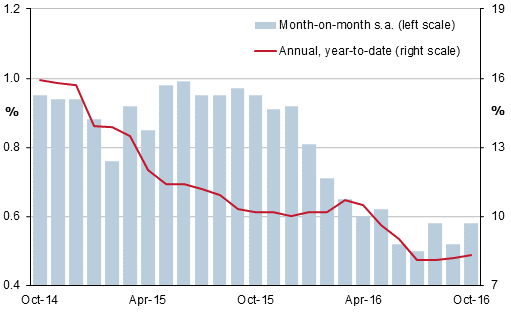In the first ten months of the year through to October, urban fixed-asset investment (FAI), excluding rural households, expanded 8.3% from the same period last year, which was above the 8.2% expansion in September. The reading was slightly above the 8.2% increase that markets had expected and represented a four-month high. A month-on-month comparison shows that investment in urban fixed assets rose a seasonally-adjusted 0.58% in October, which was slightly above the 0.52% increase in September.
The improvement observed in October reflected an acceleration in the primary and the tertiary sectors. Conversely, growth in the secondary sector decelerated in the same month. The closely-watched real estate development indicator gained steam in October and hit a five-month high. In response to the tightening measures implemented in some top cities at the start of October, developers have sped up their investment projects. However, property investment growth will likely weaken in the coming months.
Analyzing October’s data from the ownership side, investment growth among state-owned and state-holding units moderated to an eight-month low, although it still expanded a strong 20.5%. Activity among private companies accelerated in October and expanded a mild 2.5%. This combination of stronger private sector activity and a moderation among public-related companies bodes well for China’s economic transition. That said, the wide gap between the two sectors is still casting doubt on the quality of this economic rebalancing.
news
- CHINA INTERNATIONAL IMPORT EXPO
- China paces strong growth for a
- Trade war could 'hurt millions'
- 8,500+ Procurement Teams Depend
- China, Ukraine seek closer econ
- High net worth individuals are
- British companies offering insi
- New system brightens solar
- China strengthens TCM cooperati
- Made in China 2025: The plan of
Contact us

Tel.:+86-21-61811362
Fax: +86-21-61811352
Add:Rm2003-2004,Building10th,BaoLink-Center,Lane 803 of Shuangcheng Rd , Shanghai , China
Post Code: 200940
E-mail: info@daittosourcing.com

news
China: Investment growth hits four-month high in October
November 14, 2016

“Our competitive culture and vested interest to succeed represents an unparalleled motivation to make our partners' clients a success – we know if they succeed, we succeed.”
CEO